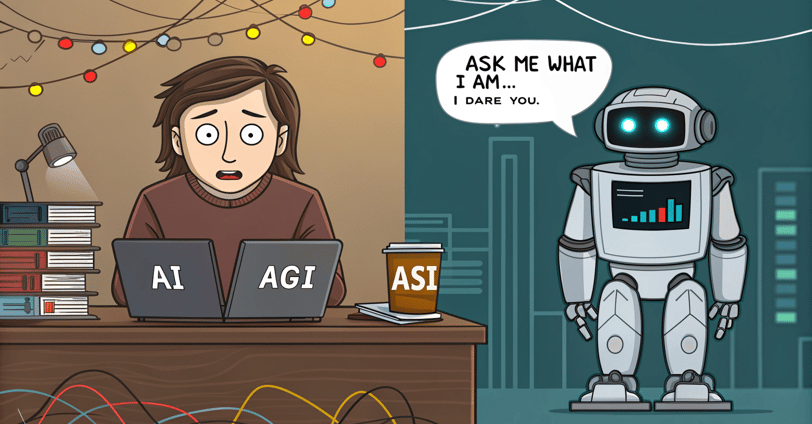Let's Get Clear on AI
AI might be learning fast, but humanity’s still catching up. This post lays out what AI really is (and isn’t), and why understanding it now might save us from someday asking Siri if she’s our overlord.
Frank B. Goodin, II
4/12/20253 min read


Somebody recently asked me: “Hey Frank, what is AI, for real for real?”
And it hit me... a lot of us are living in a world run by buzzwords we’ve never really stopped to unpack. So today, let me break it down - no jargon, no doomscrolling, just one curious human to another trying to keep it real.
First up: What is AI?
Artificial Intelligence, or AI, is basically when machines or software perform tasks that usually require human brainpower - things like recognizing patterns, making decisions, solving problems, or pretending they understand us when we ask them why our Wi-Fi is slow lol.
But here’s the deal: most of what we call AI today is what the pros call “narrow AI” (also known as weak AI - good thing the robots aren't too sensitive - yet). These AIs are great at exactly one thing.
Like Siri. She can set your alarm or ignore your existential questions.
Or AlphaGo - the program that whooped the world’s best Go players. Brilliant at Go. But useless at grocery shopping ha.
These narrow systems are specialists. They’re like the one cousin who’s amazing at chess but burns the grill cheese sandwich every single freaking time.
Now enter: AGI
That stands for Artificial General Intelligence. This is the stuff of sci-fi (for now). AGI wouldn’t just master one task - it would master any intellectual task you or I could do. Solve math? Yep. Write a poem? Sure. Give you marriage advice? …uhhh maybe.
The point is, AGI wouldn’t need us to hand-hold it through each new task. It could generalize. Think like a human as they say. Adapt on the fly. We haven’t built it yet - but plenty of very smart people believe we’re getting closer than we think.
And then there’s: ASI
Artificial Superintelligence. Think intelligence that makes Einstein look like a freshman in Calculus 101. ASI would be beyond human understanding - outthinking us in every way imaginable (and probably a few we can’t imagine).
This is where the debates get a little spicy.
But wait, ok Frank… is any of this real?
Great question. The truth is: AGI and ASI are still hypothetical. But that hasn’t stopped everyone from having a strong opinion.
Some folks argue the whole idea is overhyped marketing - like AI’s version of a Marvel origin story that never quite gets to the movie. They say obsessing over "rogue AGI" distracts from real issues we already face with current AI - like bias, inequality, misinformation, and apps that somehow know you want pizza before you do.
Others, including some of the leading voices in tech, take the opposite view:
They say if we do create AGI or ASI, and we don’t align it with human values, it could pose serious existential risks. Yes, the classic Skynet robot-overlord vibes.
Here’s where I land:
We don’t have AGI or ASI yet - but we do need to understand what they are and what they aren’t. Otherwise, we fall into one of two dangerous traps:
1- We panic over fantasy while ignoring reality.
2- We shrug off real progress and stay unprepared for what’s coming.
And honestly, both are a problem.
As an educator - and someone who wants us all to thrive in this AI-powered future - I believe we need to get clear, grounded, and intentional. Not just about what AI can do, but what it means for us.
This post is part one.
Next time, we’ll look at how fast AI is actually evolving (spoiler: faster than your last iPhone update) and what that means for schools, jobs, and yeah - life as we know it.
Let’s have this conversation together.
We need it.
This post was proudly co-written by me and my unpaid robot intern.
#AI #Education #AGI #AIliteracy #HumanCenteredAI #EthicalTech
